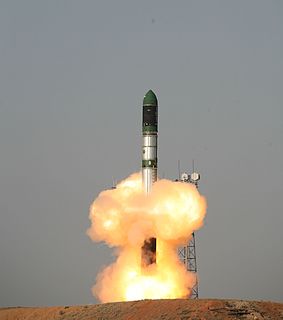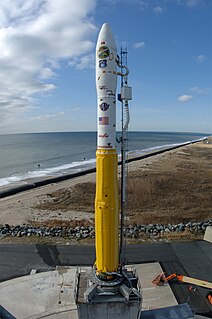| Mission type | Technology |
|---|---|
| Operator | The Aerospace Corporation |
| COSPAR ID | 2009-028E |
| SATCAT no. | 35005 |
| Spacecraft properties | |
| Spacecraft type | CubeSat (1U) |
| Launch mass | 1 kilogram (2.2 lb) |
| Start of mission | |
| Launch date | 19 May 2009, 23:55 UTC |
| Rocket | Minotaur I |
| Launch site | MARS LP-0B |
| Contractor | Orbital Sciences |
| End of mission | |
| Decay date | 6 January 2011 |
| Orbital parameters | |
| Reference system | Geocentric |
| Regime | Low Earth |
| Perigee altitude | 427 kilometers (265 mi) |
| Apogee altitude | 465 kilometers (289 mi) |
| Inclination | 40.4 degrees |
| Period | 93.51 minutes |
| Epoch | 22 May 2009 [1] |
AeroCube 3 is a single-unit CubeSat which was built and is being operated by The Aerospace Corporation. It is the third AeroCube satellite, following on from AeroCube 1, which was lost in a launch failure in 2006, and AeroCube 2 which was successfully launched in 2007 but failed immediately after launch. Compared to its predecessors it contains several improvements in its infrastructure, including a redesigned power system, replacing the older system which was responsible for the loss of AeroCube 2. Its development was funded by the United States Air Force Space and Missile Systems Center.
AeroCube 3 carried technology development experiments. The primary systems demonstrated were a two-axis solar tracker and an Earth tracker, which could be used in the guidance systems of future satellites. It also carried a 0.6-meter (2 ft 0 in) balloon used for tracking tests and to increase drag, increasing the satellite's rate of orbital decay after its mission was completed.
After launch, AeroCube-3 will remain attached to the upper stage of its carrier rocket by means of a 61-meter (200 ft) tether. Experiments will be conducted to determine the satellite's flight dynamics. A wide-angle camera will be used to image the upper stage. The satellite will also reel in the tether, moving closer to the upper stage.
Once the tethered experiments are complete, the tether will be cut, and the spacecraft will begin free-flying experiments. It will align itself with the Earth's magnetic field by means of magnets and hysteresis systems. It carries a number of sensors which will be used to record information pertaining to the surface of the Earth, which will be returned using a store and dump communications system.
It was successfully launched on an Orbital Sciences Corporation Minotaur I rocket from Pad 0B at the Mid-Atlantic Regional Spaceport, at 23:55 GMT on 19 May. It was a tertiary payload, with TacSat-3 as the primary payload and PharmaSat as the secondary. Two other CubeSats, HawkSat I and CP6, were also launched, and together the three satellites were known as the CubeSat Technology Demonstration mission.

The Polar Satellite Launch Vehicle (PSLV) is an expendable medium-lift launch vehicle designed and operated by the Indian Space Research Organisation (ISRO). It was developed to allow India to launch its Indian Remote Sensing (IRS) satellites into sun-synchronous orbits, a service that was, until the advent of the PSLV in 1993, commercially available only from Russia. PSLV can also launch small size satellites into Geostationary Transfer Orbit (GTO).

A CubeSat is a type of miniaturized satellite for space research that is made up of multiple cubic modules of 10 cm × 10 cm × 10 cm size. CubeSats have a mass of no more than 1.33 kilograms (2.9 lb) per unit, and often use commercial off-the-shelf (COTS) components for their electronics and structure. CubeSats are put into orbit by deployers on the International Space Station, or launched as secondary payloads on a launch vehicle. As of August 2021, more than 1600 CubeSats have been launched and more than 90 have been destroyed in launch failures.

A small satellite, miniaturized satellite, or smallsat is a satellite of low mass and size, usually under 500 kg (1,100 lb). While all such satellites can be referred to as "small", different classifications are used to categorize them based on mass. Satellites can be built small to reduce the large economic cost of launch vehicles and the costs associated with construction. Miniature satellites, especially in large numbers, may be more useful than fewer, larger ones for some purposes – for example, gathering of scientific data and radio relay. Technical challenges in the construction of small satellites may include the lack of sufficient power storage or of room for a propulsion system.

The Dnepr rocket was a space launch vehicle named after the Dnieper River. It was a converted ICBM used for launching artificial satellites into orbit, operated by launch service provider ISC Kosmotras. The first launch, on April 21, 1999, successfully placed UoSAT-12, a 350 kg demonstration mini-satellite, into a 650 km circular Low Earth orbit.

FalconSAT is the United States Air Force Academy's (USAFA) small satellite engineering program. Satellites are designed, built, tested, and operated by Academy cadets. The project is administered by the USAFA Space Systems Research Center under the direction of the Department of Astronautics. Most of the cadets who work on the project are pursuing a bachelor of science degree in astronautical engineering, although students from other disciplines join the project.

The Minotaur I, or just Minotaur is an American expendable launch system derived from the Minuteman II missile. It is used to launch small satellites for the US Government, and is a member of the Minotaur family of rockets produced by Orbital Sciences Corporation.
The Space Test Program (STP) is the primary provider of spaceflight for the United States Department of Defense (DoD) space science and technology community. STP is managed by a group within the Advanced Systems and Development Directorate, a directorate of the Space and Missile Systems Center of the United States Space Force. But STP is a DoD-wide organization. STP provides spaceflight via the International Space Station, piggybacks, secondary payloads and dedicated launch services.
The Multi-Application Survivable Tether (MAST) experiment was an in-space investigation designed to use CubeSat spacecraft connected by tethers to better understand the survivability of tethers in space. It was launched as a secondary payload on a Dnepr rocket on 17 April 2007 into a 98°, 647 x 782 km orbit. The MAST payload incorporated three picosatellites, named "Ralph," "Ted," and "Gadget," which were intended to separate and deploy a 1 km (0.62 mi) tether. The experiment hardware was designed under a NASA Small Business Technology Transfer (STTR) collaboration between Tethers Unlimited, Inc. (TUI) and Stanford University, with TUI developing the tether, tether deployer, tether inspection subsystem, satellite avionics, and software, and Stanford students developing the satellite structures and assisting with the avionics design.

NanoSail-D was a small satellite which was to have been used by NASA's Ames Research Center to study the deployment of a solar sail in space. It was a three-unit CubeSat measuring 30 by 10 by 10 centimetres, with a mass of 4 kilograms (8.8 lb). The satellite was lost shortly after launch due to a problem with the rocket carrying it; however, a replacement, NanoSail-D2, was launched in 2010 to complete its mission.

Minotaur IV, also known as Peacekeeper SLV and OSP-2 PK is an active expendable launch system derived from the LGM-118 Peacekeeper ICBM. It is operated by Northrop Grumman Innovation Systems, and made its maiden flight on 22 April 2010, carrying the HTV-2a Hypersonic Test Vehicle. The first orbital launch occurred on 26 September 2010 with the SBSS satellite for the United States Air Force.
Orbcomm is a family of low Earth orbit communications satellites, operated by the United States satellite communications company Orbcomm. As of July 2014, 51 such satellites have orbited Earth, with 50 still continuing to do so.
HawkSat I is a single-unit CubeSat which was built and is being operated by the Hawk Institute for Space Sciences. It is based on a Pumpkin Incorporated CubeSat kit, and carries a technology demonstration payload, primarily as a proof-of-concept mission, testing command, data and power subsystems, as well as solar panels and communications.
CP6, also known as PolySat-6, PolySat CP-6 or CalPoly 6 is a single-unit CubeSat which was built and operated by the California Polytechnic State University. It was primarily intended to perform a technology demonstration mission. The main experiment consisted of sensors to determine the spacecraft's attitude. Cameras on the satellite will be used to verify the data returned by the attitude sensors. Originally built as a backup to CP3, which was launched in April 2007, CP6 was modified after it was decided that it would no longer be needed for that role.
Negai☆″ is a Japanese satellite which launched in May 2010. It is a student-built spacecraft, which will be operated by Soka University, and is intended to be used for technology demonstration. The satellite is a single unit CubeSat, and will be used to test a field programmable gate array in orbit. As part of an outreach programme, it will carry the names of selected children, along with wishes they have made. The satellite will return images of the Earth, which will be given to the participating children.

A number of space tethers have been deployed in space missions. Tether satellites can be used for various purposes including research into tether propulsion, tidal stabilisation and orbital plasma dynamics.
Hermes was an American satellite which was to have been operated by the Colorado Space Grant Consortium. Intended to perform technology demonstration experiments in low Earth orbit, it was lost during launch in March 2011 when the rocket that was carrying it failed to achieve orbit.

LauncherOne is a two-stage orbital launch vehicle developed and flown by Virgin Orbit that began operational flights in 2021, after being in development from 2007 to 2020. It is an air-launched rocket, designed to carry smallsat payloads of up to 300 kg (660 lb) into Sun-synchronous orbit (SSO), following air launch from a carrier aircraft at high altitude. The rocket is carried to the upper atmosphere on a modified Boeing 747-400, named Cosmic Girl, and released over the Pacific Ocean. Initial work on the program was done by Virgin Galactic, another Virgin Group subsidiary, before a separate entity— Virgin Orbit—was formed in 2017 to complete development and operate the launch service provider business as a separate entity from the passenger-carrying Virgin Galactic business.

ESTCube-1 is the first Estonian satellite and first satellite in the world to attempt to use an electric solar wind sail (E-sail). It was launched on 7 May 2013 aboard Vega VV02 carrier rocket and successfully deployed into orbit. The CubeSat standard for nanosatellites was followed during the engineering of ESTCube-1, resulting in a 10×10×11.35 cm cube, with a volume of 1 liter and a mass of 1.048 kg.

USA-261, also referred to as Orbital Test Vehicle 4 (OTV-4) or AFSPC-5, is the second flight of the second Boeing X-37B, an American unmanned vertical-takeoff, horizontal-landing spaceplane. It was launched to low Earth orbit aboard an Atlas V rocket from Cape Canaveral on May 20, 2015. Its mission designation is part of the USA series.